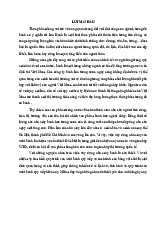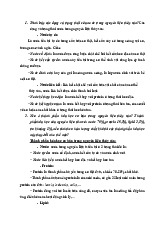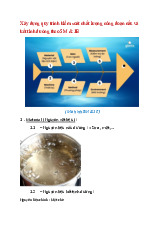



Preview text:
Novel cryogenic technologies for the freezing of food products
Silvia Estrada-Flores Ph.D.
Senior Research Engineer. Supply Chain Innovation Food Science Australia Abstract
Innovative cryogenic freezing technologies can be used to produce high quality frozen
foods. A recent patent survey from 40 patent-issuing authorities around the world showed
that only 1.2% of the total patents granted for cryogenics in the past 11 years refer to food
freezing technologies. The potential for the development of new cryogenic equipment and processes is still enormous.
This paper presents the fundamentals of cryogenic freezing and the trends in food freezing
technologies, discussing some technical descriptions of representative freezing equipment
developed in the past decade. Product quality issues encountered when using cryogenic
systems with inappropriate knowledge of the product or inadequate cold chain after
cryogenic freezing -i.e. recrystallization, mechanical damage and others- are also addressed. Key Words: 1. INTRODUCTION
Food processing is Australia’s largest manufacturing industry, with a growth of
approximately 36% in the past decade [1]. One of the key strategies for improving the
profits of the Australian food industry is increasing the value of raw materials and
extending the shelf life of high value products through operations such as freezing. The
industry is always looking for innovative ways of producing high quality frozen foods and
methods of maintaining this quality through to the point of consumption. The use of
cryogenic technologies might be the answer to these needs.
Cryogenic refrigeration refers to the use of expandable gaseous refrigerants, such as argon,
oxygen, hydrogen, nitrogen, carbon dioxide and others, that at atmospheric pressure
evaporate or sublime at very low temperatures. In the food industry, the most popular
cryogenic substances are nitrogen (N2) and carbon dioxide (CO2).
Some of the benefits of cryogenic freezing and chilling include short cooling/freezing
times, reduction in dehydration and drip loss and improved texture of products due to the growth of small ice crystals.
A patent survey was conducted from 40 patent-issuing authorities in the US, Japan, PCT
(World Patent Office) and major European countries (Derwent Innovations Index®. ISI
Web of Knowledge™, 2002). This survey showed that 4,604 patents have been granted in
the past 11 years for cryogenic technologies in the most important 23 industrial fields
worldwide, including polymer engineering, chemical engineering and semiconductors,
amongst others. From these, only 57 patents were related to either new developments or
improvements on cryogenic freezing technologies for foodstuffs, which represents 1.2% of
the total. The potential for the development of new cryogenic equipment and processes is still enormous.
2. HEAT TRANSFER MECHANISMS DURING CRYOGENIC FREEZING
The rate of heat transfer during freezing is influenced by several factors. Some of these are
the thermal properties of the food, the surface area of the product available for heat transfer,
the size and shape of the product, the temperature difference between the food and the
freezing medium, the insulating effect of air surrounding the food and the presence of
packaging materials. These factors are significant for mechanical and cryogenic freezing
alike. However, the heat transfer phenomena occurring in cryogenic freezing differs from
that observed in mechanical systems in several aspects. Figure 1 illustrates the heat transfer
phenomena expected during cryogenic freezing.
The most common process in cryogenic freezing is spraying the surface of the product with
either N2 or CO2. Though the method of application for both substances is similar, the
behaviour of these is quite different: when liquid CO2 is fed into a spay nozzle, the CO2
expands and changes to approximately equal parts (by weight) of solid and vapour. The
flow of the “snow” (e.g. a mixture of solid particles and vapour), the CO2 distribution
system and internal convective mechanisms create air/CO2 currents within the freezer. As
solid CO2 particles contact the food surface, the solid almost instantly sublimes to vapour,
which draws heat out of the product. This system provides approximately 85% of the
refrigeration effect from the sublimation of the solid carbon dioxide. The remaining 15%
of the cooling is a result of the contact of the product with air/CO2 mixture. To obtain the
maximum refrigeration benefit, a typical CO2 system will inject CO2 throughout the length of the freezer [2].
In N2 systems, the N2 is sprayed into the freezer and separates as liquid and vapour. As
droplets touch the product surface, the liquid changes to vapour, extracting latent heat from
the food surface in the process. The vapour distribution through the freezer creates
convective currents that increase the freezing rate. In this case, about 50% of the
refrigeration effect is supplied by the N2 phase change from liquid to vapour. The
remaining heat is removed by the N2 vapour flowing through the freezer.
It should be noted that heat removal would not induce phase change by itself: additional
factors such as the rate of formation of ice crystals and the propagation of these in the food structure are involved.
Figure 1. Representation of heat transfer phenomena during cryogenic freezing
[1] Heat transfer product-to-mixture of air and refrigerant (either CO2, snow or N2,vapour)
[2] Heat transfer product-to-refrigerant (either CO2,solid or N2,liquid)
[3] Direct sublimation of CO2, snow on food surface OR direct evaporation of N2, liquid on food surface
[4] Radiative heat transfer product => colder surroundings
The freezing of food materials is more complex than the freezing of pure water. All food
materials contain solutes such as carbohydrates, salts, colorants and other compounds
which affect their freezing behaviour. Most food products contain animal and/or vegetable
cells forming biological tissues. The water content of these tissues is either inside the cells
(intracellular fluid) or surrounding these (extracellular fluid). Since the lowest
concentration of solutes is found in the extracellular fluids, the first ice crystals are formed
there. During a slow freezing, there will be time for the cell to lose water by diffusion and
the water will freeze on the surface of the crystals already formed. As the cells keep losing
water, the cell shrinks more and more until it collapses [3]. The large ice crystals will exert
pressure on the cellular walls, contributing to drip loss during thawing. A rapid freezing
promotes a large number of small ice crystals distributed uniformly throughout the tissue,
both inside and outside the cells [4]. Hence, products frozen with cryogenic technologies
show a matrix of small ice crystals and a better texture than products frozen using slower heat transfer processes.
Jul [5] describes several cases involving frozen beef and lamb meat in which fast freezing
rates did not result in better product quality. However, Jul also describes specific examples
where cryogenic freezing has shown advantages over mechanical freezing, such as texture
improvements in frozen fish and shellfish, tomato slices and dairy products [5].
Detrimental effects of quick freezing can occur in some products, due to considerable
internal strain, surface ruptures and cell structural changes.
Quality losses are also related to breakages of the cold chain, such as those commonly
encountered in retail and domestic storage. Most frozen products will be stored in
commercial and domestic freezers, where temperature abuse is not uncommon, due to the
design of defrost and temperature control systems and the practices followed by the users
of domestic and commercial appliances. The author has evaluated a variety of domestic
refrigerators and found that air temperatures in the freezer compartment of domestic
refrigerators can rise from -20ºC to +18ºC during defrost [6]. Billiard et al. [7] observed
similar air temperatures during defrosting of horizontal open frozen food display cabinets
commonly used in retail sales of frozen foods. Evaporator defrost of commercial and
domestic refrigerators will lead to partial thawing of the frozen product, with the product
surface temperature following closely that of the surrounding air (+18ºC). A defrost period
occurs typically in a cycle of 8 to 12 hours; hence, this temperature abuse is significant and
should be considered when calculating actual shelf life losses for frozen products. Even the
best freezing technology will not prevent the loss of quality in frozen products that are
subjected to temperature abuse before and after the freezing process. Cryogenically frozen
products can be more sensitive to these temperature abuses due to the delicate matrix of
ice crystals formed initially and the higher temperature difference between freezing and storage.




